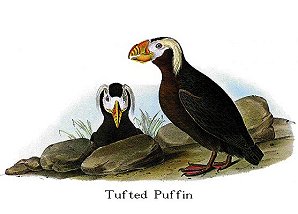
| Family XLIV. ALCINAE. AUKS. GENUS I. MORMON, Illiger. PUFFIN. |
Next >> |

Family |
THE TUFTED PUFFIN. [Tufted Puffin.] |
| Genus | MORMON CIRRHATUS, Lath. [Fratercula cirrhata.] |
The specimen from which I drew the figure of this singular looking bird,
was procured at the mouth of the Kennebec river, in Maine. It was shot by a
fisherman gunner, while standing on some floating ice, in the winter of 1831-32.
No other individual was seen. I could not obtain any information respecting its
habits; but as the bird was in tolerable order, I hope that my figures of it
will prove not unacceptable. It was a male, and appeared to be adult. My
friend, the Prince of MUSIGNANO, mentions this species as being an inhabitant of
the seas between North America and Kamtschatka, being, he adds, often found on
the western coasts of the United States in winter.
ALCA CIRRHATA, Lath. Ind. Orn., vol. ii. p. 791.
MORMON CIRRHATUS, Bonap. Syn., p. 429.
TUFTED MORMON or PUFFIN, Nutt. Man., vol. ii. p. 539.
TUFTED PUFFIN, Mormon cirrhatus, Aud. Orn. Biog., vol. iii. p. 364.
Male, 15, 22 1/2.
Extremely rare and accidental on the coast of the United States in winter.
Common in the Arctic Seas, and on the north-west coast of America.
Adult Male.
Bill about the length of the head, nearly as high as long, extremely
compressed, at the base as high an the head, furrowed on the sides. Upper
mandible with a horny rim along the basal margin, its dorsal line convex to the
middle, or along the extent of a long, narrow, rounded dorsal prominence, which
extends from the base to the first groove, afterwards curved in the fourth of a
circle, the ridge narrow, in its basal half rounded, narrower and rather sharp
towards the end, the sides slightly convex, and marked with four curved
transverse grooves, between the nostril and the tip, the edges rather blunt,
nearly straight until close to the decurved, narrow, obtuse tip. The basal rim
is scrobiculate, the rest of the mandible smooth. The nostrils are linear,
direct, close to the edge, and near the base. Lower mandible with the angle
extremely short and narrow, the dorsal line nearly straight and ascending, the
sides slightly concave, without grooves, the ridge narrow but convex, the tip
very narrow, obliquely truncate. The gap extends downwards a little beyond the
base of the bill, and is furnished with a soft corrugated extensible membrane.
Head large, oblong, anteriorly compressed; eye of moderate size, with the
edges of the eyelids bare; neck short and thick; body full and rounded. Feet
short, rather stout; tibia bare for a short space above the joint; tarsus very
short, anteriorly with a series of small scutella, the rest with small roundish
scales. Hind toe wanting; toes of moderate length, rather slender, scutellate
above, connected by reticulated entire membranes, the third toe longest, the
fourth little shorter, the second considerably shorter, with a narrow marginal
web. Claws strong, of moderate length, compressed, arched, that of the inner
toe much curved, of the middle toe with a thin inner edge.
Plumage close, blended, soft, very short on the head, where, however, along
a line over and behind the eye, there is on each side a tuft of long, very
slender, acute incurved feathers, of a shining hair-like texture. Wings rather
short, curved, narrow, acute; primary quills narrow, incurved, first longest,
second slightly shorter, the rest rapidly graduated; secondaries very short,
small and rounded. Tail very short, slightly rounded, of sixteen narrow,
rounded, decurved feathers.
Bill light yellowish-red, the basal rim and the ridge towards the end of
the upper mandible bright red, as is the edge of the eyelids. Iris light blue.
Feet bright red; webs of a deeper tint; claws black. Sides of the head white;
upper part brownish-black; the elongated feathers behind the eye pale yellow.
The general colour of the upper parts is brownish-black, glossed with blue, of
the lower deep purplish-brown.
Length to end of tail 15 inches, to end of wings 14, to end of claws 14;
extent of wings 22 1/2; wing from flexure 8 4/12; tail 2 1/4; bill along the
ridge 2 3/4, along the edge of lower mandible 1 11/12; tarsus 1 5/12; middle toe
1 10/12, its claw 7/12.
| Next >> |